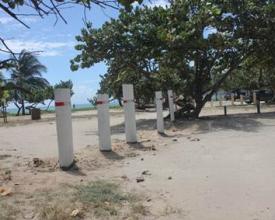
Protección del litoral en la zona medioambiental protegida de Point Sables (PSEPA), Santa Lucía

El PSEPA cuenta con una biodiversidad única, así como con mares y paisajes cautivadores. Ha sido sobreexplotado por usuarios con intereses contrapuestos, lo que ha provocado conflictos, compactación de las playas, desvegetación del litoral, erosión y sedimentación de los desagües y de la barrera de coral. El Patronato Nacional de Santa Lucía utiliza un enfoque múltiple con elementos básicos, como el compromiso continuo de las partes interesadas y el apoyo científico, para abordar estos problemas. Las intervenciones para estabilizar y mejorar la PSEPA incluyen:
- Gestión integrada y revegetación del litoral, las dunas y los manglares.
- Exclusión de vehículos de la playa
- Limpieza y rehabilitación de los desagües pluviales
- Mejora de la gestión de residuos
- Establecimiento de asociaciones con los usuarios y las partes interesadas privadas y públicas para fomentar una amplia participación, fomentar el cumplimiento voluntario y mejorar las oportunidades de subsistencia basadas en los recursos naturales.
- Elaboración de un plan participativo de uso recreativo de Sandy Beach
- Campaña de concienciación y educación pública
Impactos
Las intervenciones tienen como objetivo un disfrute más sostenible de la PSEPA por parte de todos los usuarios. Se salvaguardarán los servicios ecosistémicos que prestan los bosques agroforestales costeros, las playas y los arrecifes de coral, de modo que puedan seguir sustentando la flora y la fauna autóctonas, los medios de subsistencia asociados, así como aumentar la resiliencia frente a fenómenos climáticos adversos.
En concreto, la rehabilitación de los desagües pluviales ya permite un drenaje más eficaz tras las lluvias torrenciales, evitando así una mayor erosión del agua. La revegetación en curso de las dunas de arena y la repoblación forestal costera evitarán aún más la erosión eólica y contrarrestarán el impacto de la extracción ilegal de arena. Los pilares impiden ahora el tráfico de vehículos por la playa, contrarrestando así la compactación y preservando la estética del lugar. Ya no se observa la extracción de arena y hay indicios de regeneración de plantas y dunas. La basura se ha reducido visiblemente gracias a la instalación de contenedores y a la mejora de las rutinas de recogida.
La educación y sensibilización continuas del público ya han llegado a más de 1.500 personas directamente, y a muchas más a través de las redes sociales, lo que ha contribuido a mejorar el comportamiento de los usuarios y a generar orgullo entre los posibles administradores. El Patronato Nacional de Santa Lucía busca continuamente oportunidades de financiación de diversas fuentes para desarrollar soluciones integradas que se apoyen unas en otras.






